
Sarah Bauder
Sarah has been writing on the topics of politics, history and finance for over a decade. She is currently an editor at CPI Inflation Calculator, covering the topics of CPI, inflation, US economy and economic commentary.
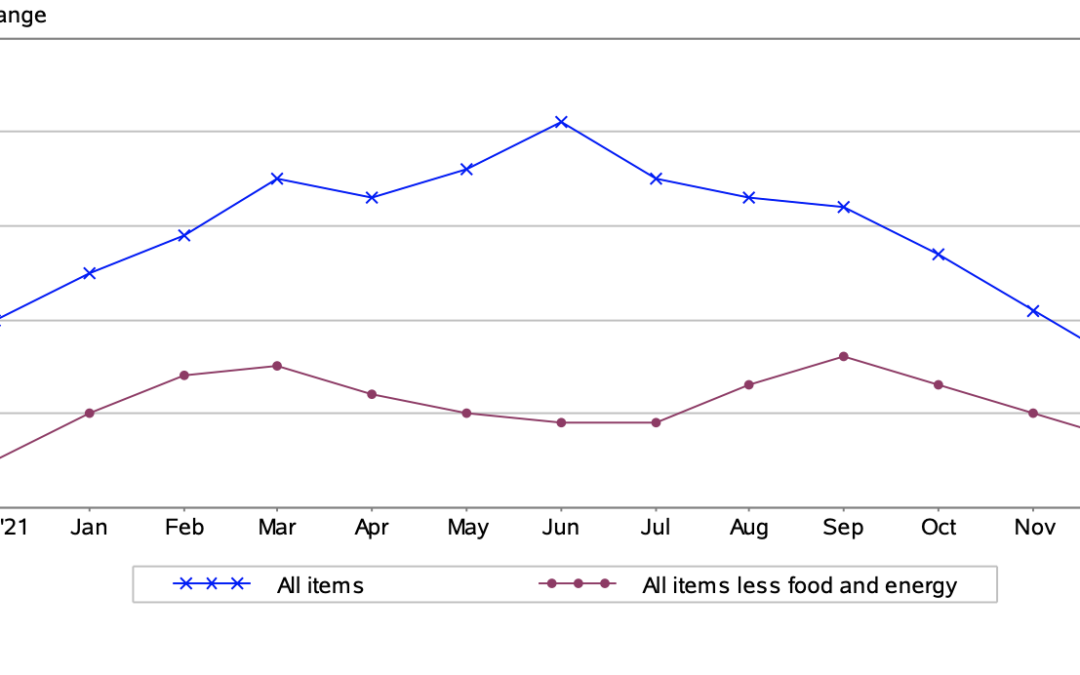
by Sarah Bauder | Jan 12, 2023 | CPI
The Consumer Price Index for All Urban Consumers (CPI-U) decreased by 0.1% on a seasonally adjusted basis, reported the Bureau of Labor Statistics. Year-over-year, before seasonal adjustment the all items index grew by 6.5%.
The primary contributing variable to the deceleration in inflation was the drop in the price of gasoline. The price of foodstuffs at grocery stores increased, as did shelter costs, albeit at a slower pace.
Despite the fact that inflation in the United States appears to be slowing down, the Federal Reserve has indicated that more interest rate hikes will transpire into 2023 to curtail the soaring cost of living.
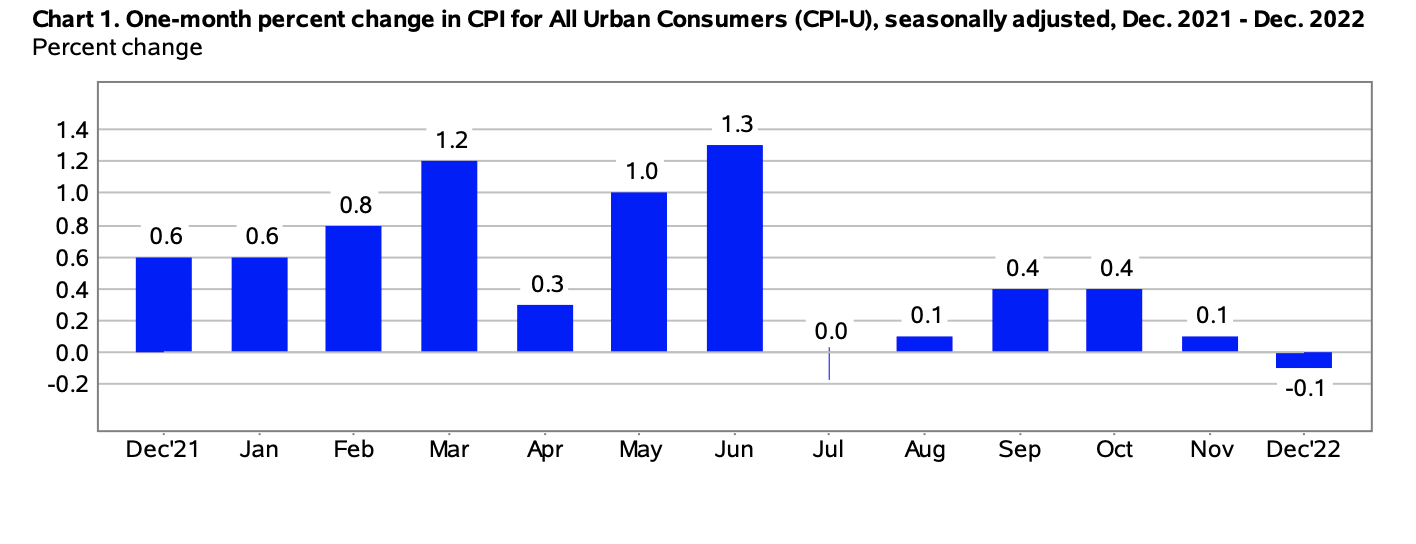
(Source: U.S. Bureau of Labor Statistics)
Food
In December, the index for food rose by 0.3%, after a 0.5% increase from the previous month. Over the last 12-month span, American consumers have paid 11.8% more for food items from grocery stores.
Grocery items that saw price increases in December included meats, poultry, fish, and eggs. Conversely, the prices for fresh fruits and vegetables and bakery products declined. Moreover, American consumers paid more to dine out in restaurants in December.
Gasoline Prices
In December, American consumers again paid less to gas up their vehicles. The price of gasoline dropped by 9.4% over the month, after the 2% decrease seen in November.
In December, prior to seasonal adjustment, the price of gasoline declined 12.5%.
Since this time last year, gasoline prices have decreased by 1.5%.
Energy
In December, the index for energy dropped 4.5%. This was primarily due to the decline in gasoline prices. However, American consumers paid 3% more for natural gas and 1% more for electricity over the month.
Year-over-year, the index for energy grew by 7.3%. Since this time last year, fuel oil prices surged by 41.5%. Likewise, American consumers paid 19.3% more for natural gas and 14.3% more for electricity over the last 12-month period.
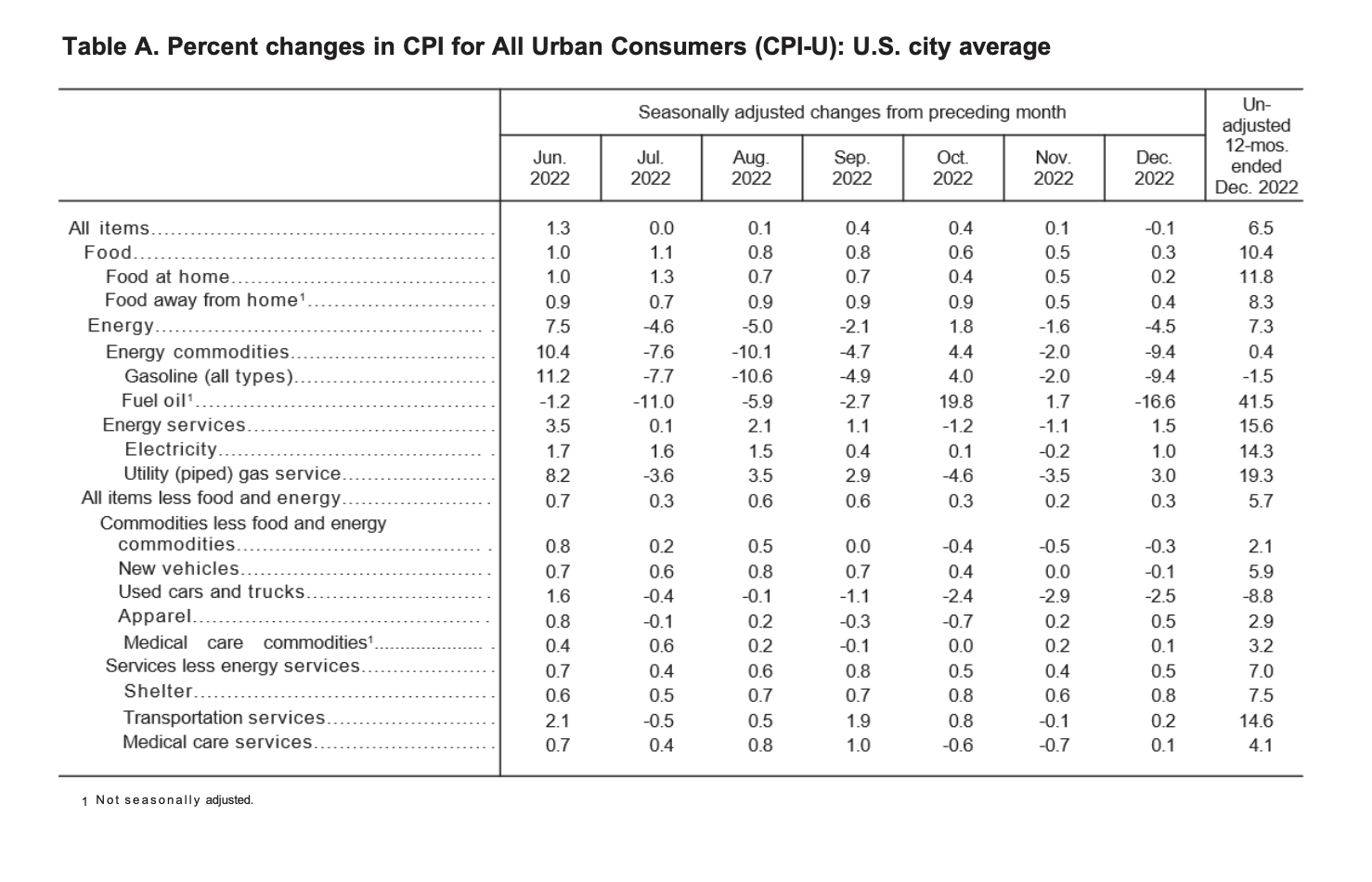
(Source: U.S. Bureau of Labor Statistics)
All Items Less Food and Energy
In December, the all items less food and energy index edged up 0.3%. Unfortunately, American consumers continued to pay more shelter costs. The index for shelter rose 0.8% over the month.
Both the index for rent and the index for owners’ equivalent rent (which is correlated to the value of housing prices) increased by 0.8%, respectively.
“The shelter index was the dominant factor in the monthly increase in the index for all items less food and energy, while other components were a mix of increases and declines,” explained the Bureau of Labor Statistics in its monthly report.
Over the last 12-month period, the composite index for shelter increased by 7.5% – the most significant contributor to the overall percentage increase of the all items less food and energy index.
Other composite indexes that saw percentage increases since this time last year include furnishings and operations (+6.7%), new vehicles (+5.9%), recreation (+5.1%), and medical care (+4.0%).
Year-over-year, the all items less food and energy index increased by 5.7%.
Want to learn more about how inflation is impacting the economy? Have a look at our table highlighting information regarding the 2022 CPI and Inflation Rate for the United States, try our calculator widget, and subscribe to our newsletter.
Source Cited: https://www.bls.gov/news.release/cpi.nr0.htm
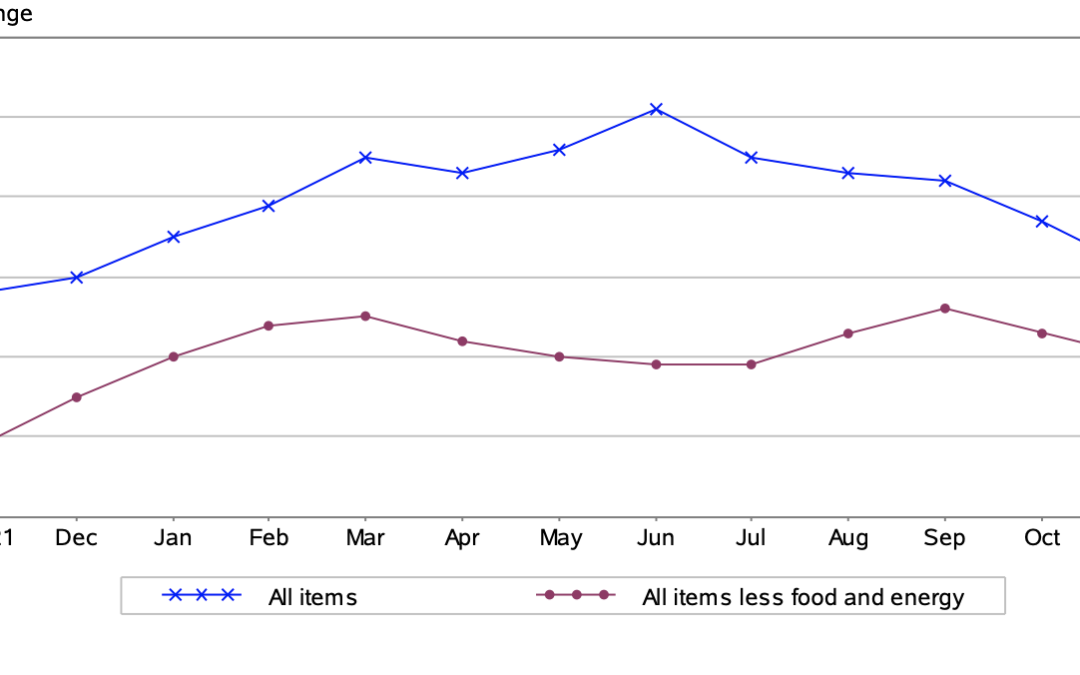
by Sarah Bauder | Dec 13, 2022 | CPI
The Consumer Price Index for All Urban Consumers (CPI-U) rose by 0.1% on a seasonally adjusted basis in November, reported the U.S. Bureau of Labor Statistics. Year-over-year, prior to seasonal adjustment the all items index rose 7.1%.
The primary factor for the percentage increase seen in November was the rise in the shelter index. In addition, the cost of foodstuffs at grocery stores increased, while energy costs declined over the month.
“The index for shelter was by far the largest contributor to the monthly all items increase, more than offsetting decreases in energy indexes,” explained the Bureau of Labor Statistics in its monthly report.
For American consumers, this means that they paid more for shelter costs and foodstuffs at grocery stores. Despite the fact that inflation decelerated in November, many Americans are finding it challenging to meet their daily needs.
In November, based on the data inflation cooled in the United States. For its part, the Fed is expected to slow its interest rate hikes in December.
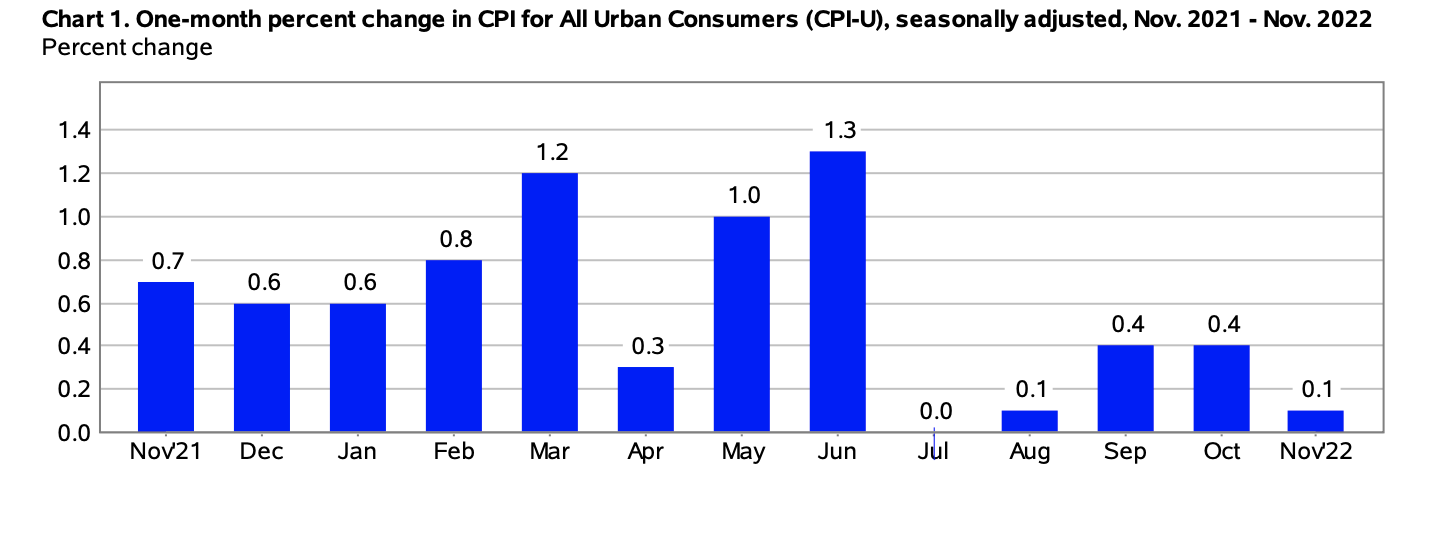
(Source: U.S. Bureau of Labor Statistics)
Food
In November, the index for food rose 0.5%. Moreover, foodstuffs purchased from a grocery store (the food at home index) increased 0.5% over the month. Over the last 12-month period, American consumers paid 12% more for food from grocery stores.
Grocery items that were the main contributors to the overall rise in the index included fruits and vegetables, cereal products, bakery products, and nonalcoholic beverages. Conversely, the composite index for meats, poultry, fish, and eggs dropped 0.2%, the index for beef fell 0.8%, and the pork index dropped 0.3%, respectively, in November.
The Price of Gasoline
American consumers paid less for gasoline at the pumps over the month. The price of gasoline declined by 2% in November, after the 4% rise seen the previous month.
In November, prior to seasonal adjustment, the price of gasoline dropped 3.6%.
Year-over-year, the price of gasoline has risen by 10.1%.
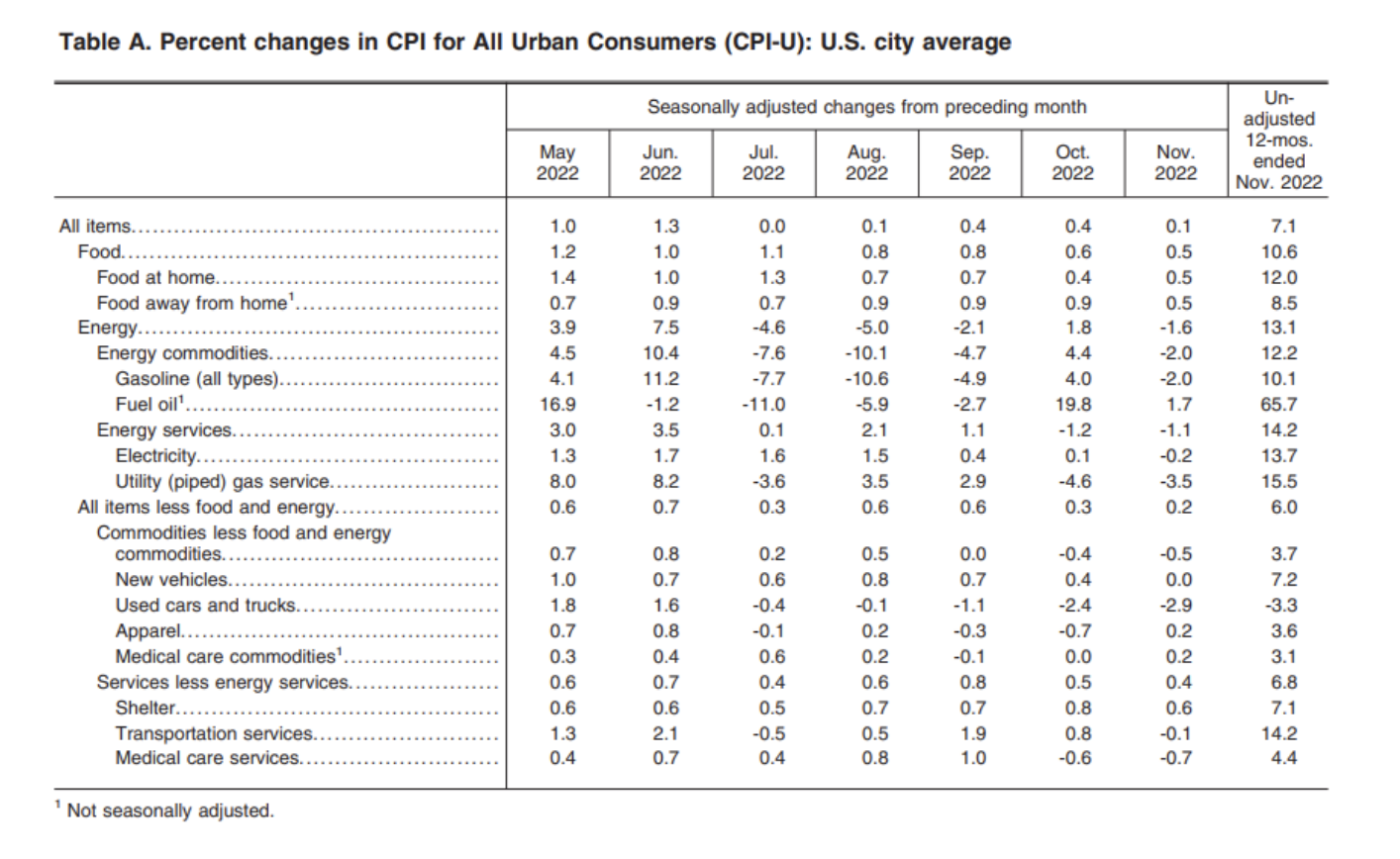
(Source: U.S. Bureau of Labor Statistics)
Energy
In November, the index for energy declined 1.6%, largely because of the decrease in the respective prices of gasoline, natural gas, and electricity.
American consumers paid 3.5% less for natural gas, and 0.2% less for electricity over the month.
Since this time last year, the index for energy grew by 13.1%. Year-over-year, the price of fuel oil skyrocketed an astounding 65.7%. In addition, American consumers paid 15.5% more for natural gas and 13.7% more for electricity since this time last year.
All Items Less Food and Energy
In November, the all items less food and energy index edged up 0.2%. Americans continued to pay more shelter themselves, as the index rose 0.6% over the month.
Furthermore, rent prices also increased by 0.8%, and the index for owners’ equivalent rent, which is correlated to the value of housing prices, rose 0.7% over the month.
The US Bureau of Labor Statistics noted that the index for shelter was the primary factor for the monthly rise in the percentage of the all items less food and energy index.
Year-over-year, the all items less food and energy index increased by 6%. Over the last 12-month span, the composite index for shelter rose 7.1%. Additionally, the index for medical care grew by 4.2% and new vehicles cost American consumers 7.2% more since thos time last year.
Want to learn more about how inflation is impacting the economy? Here is our table highlighting the 2022 CPI and Inflation Rate for the United States, try our U.S. inflation calculator, and subscribe to our newsletter.
Source Cited: https://www.bls.gov/news.release/archives/cpi_12132022.htm
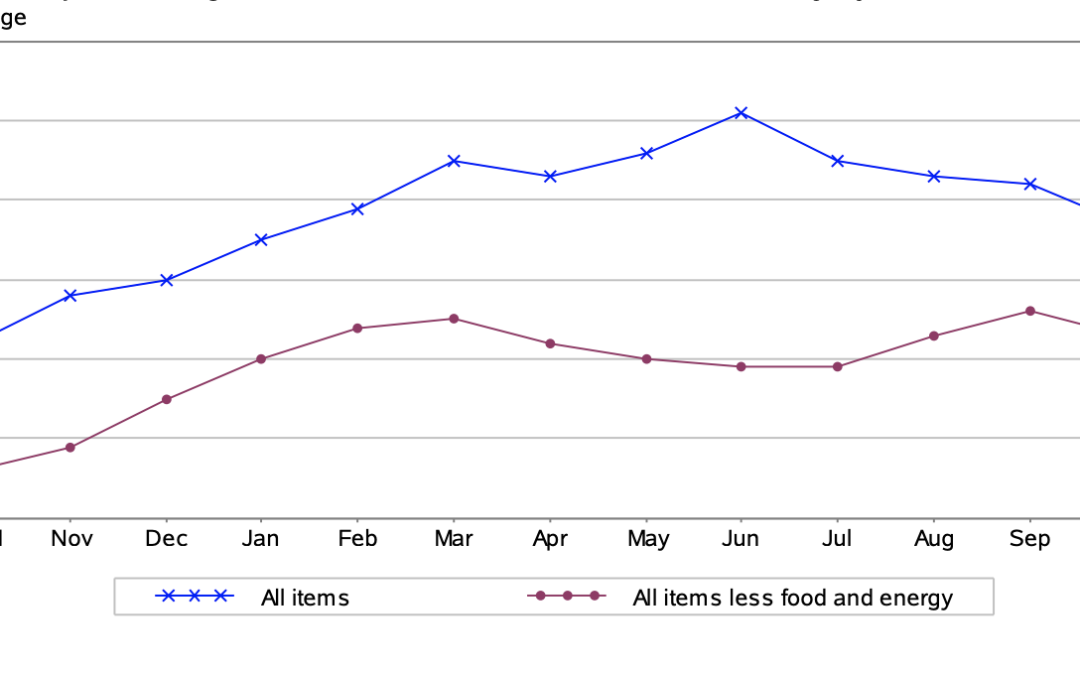
by Sarah Bauder | Nov 10, 2022 | CPI
The Consumer Price Index for All Urban Consumers (CPI-U) edged up by 0.4% on a seasonally adjusted basis in October, reported the U.S. Bureau of Labor Statistics. This is the identical percentage increase seen in September. Year-over-year, prior to seasonal adjustment the all items index rose by 7.7%.
The primary contributors to the percentage rise seen in October were a rise in shelter costs, food, and the price of gasoline.
“The index for shelter contributed over half of the monthly all items increase, with the indexes for gasoline and food also increasing,” explained the Bureau of Labor Statistics in its monthly report.
For American consumers, this means they paid more for shelter costs, and food items at grocery stores, in addition to paying more at the gas pumps. Ultimately, this denotes that many Americans are still contending with meeting basic daily needs.
Despite the fact that core inflation decelerated in October, nonetheless, the Federal Reserve increased interest rates to their highest levels since 2008.
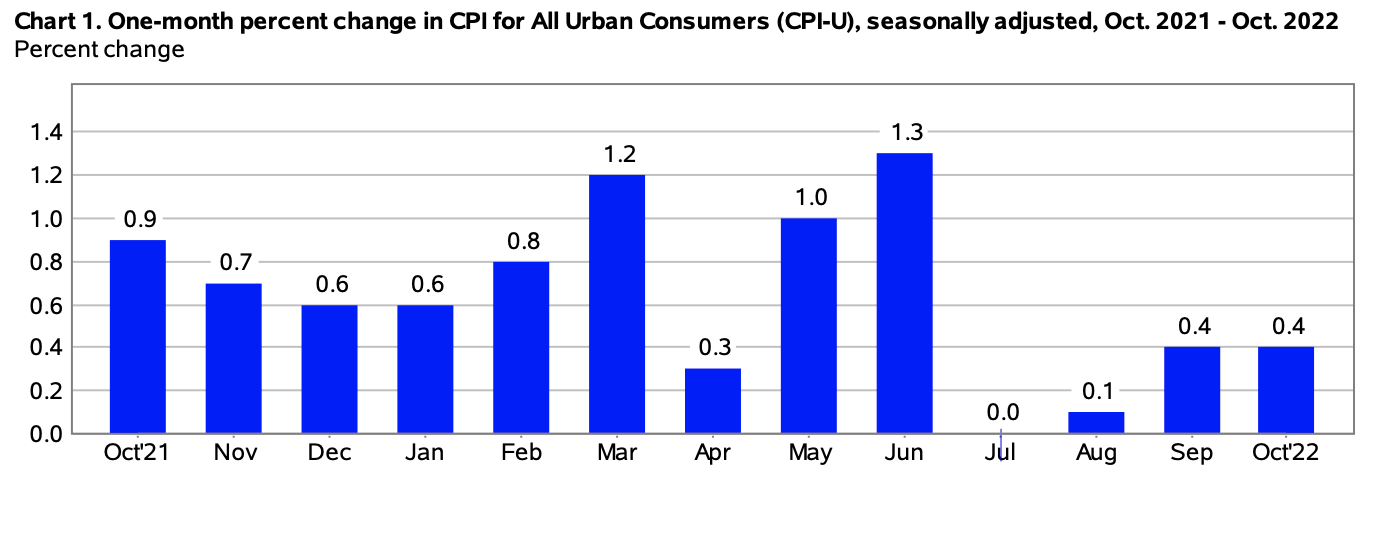
(Source: U.S. Bureau of Labor Statistics)
Food
In October, the index for food rose 0.6%. The index for food at home, which indicates foodstuffs at grocery stores increased by 0.4%. It should be noted that this marks the lowest monthly percentage increase seen since December 2021.
Since this time last year, American consumers have paid more for food items bought at grocery stores, as the index for food at home increased by 12.4%. Year-over-year, grocery items that were the main contributors to the overall increase in the index included cereals and bakery products, dairy and related products, in addition to meats, poultry, fish, and eggs.
Gas Prices
American consumers paid more at the gas pumps in October. Gas prices increased by 4% in October, after consumers enjoyed a bit of respite with lower prices for gasoline seen over the previous three months.
In October, prior to seasonal adjustment, the price of gasoline increased by 3.1%.
Over the last 12-month period, the price of gasoline rose by 17.5%.

(Source: U.S. Bureau of Labor Statistics)
All Items Less Food and Energy
In October, the all items less food and energy index increased 0.3%. American consumers continued to pay more for shelter, as the index grew 0.8% over the month. It should be noted that this is the largest monthly rise in shelter costs since August 1990.
Furthermore, rent prices also rose 0.7%, as did the index for owners’ equivalent rent by 0.6%, which is correlated to the value of housing prices.
Conversely, Americans paid less for medical costs in October. The index for medical care dropped 0.5%. Over the month, major medical care composite indexes saw percentage declines. The hospital services index fell 0.2%, and the price of prescription drugs dropped 0.1%.
Year-over-year, the all items less food and energy index increased by 6.3%. Over the last 12-month span, 6.9%. Likewise, the index for medical care increased by 5% since this time last year.
Want to learn more about how inflation is impacting the economy? Here is our table highlighting the 2022 CPI and Inflation Rate for the United States, try our U.S. inflation calculator, and subscribe to our newsletter.
Source Cited: https://www.bls.gov/news.release/archives/cpi_11102022.htm
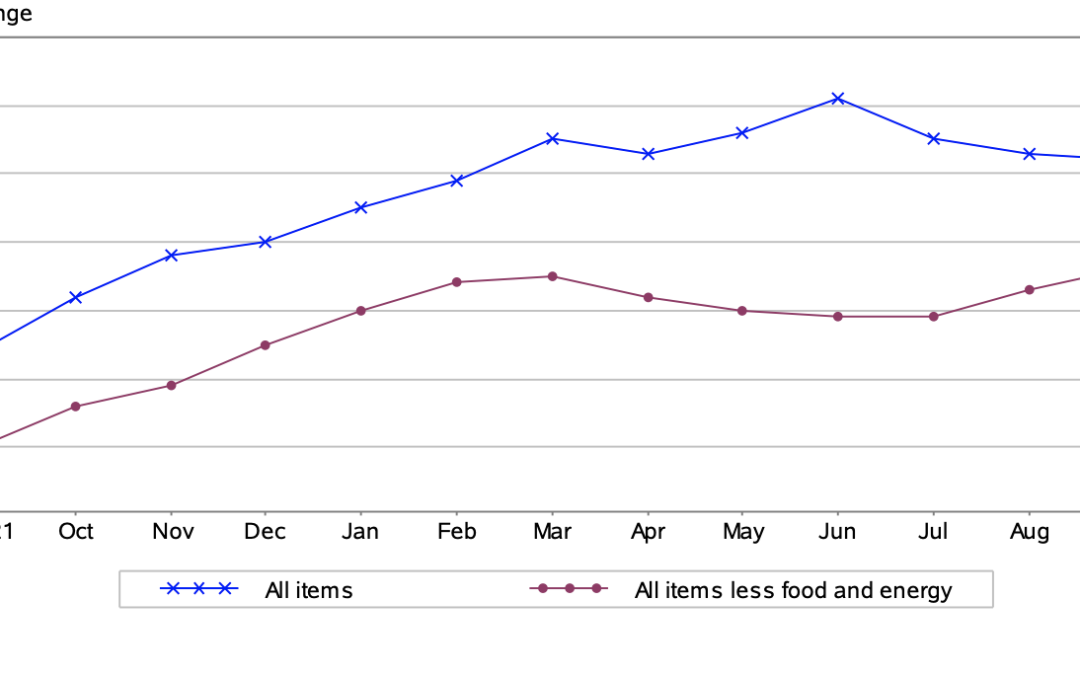
by Sarah Bauder | Oct 13, 2022 | CPI
The Consumer Price Index for All Urban Consumers (CPI-U) increased 0.4% on a seasonally adjusted basis, reported the Bureau of Labor Statistics. Year-over-year, before seasonal adjustment the all items index grew by 8.2%.
The primary reason for the percentage increase seen in September was the food, shelter, and medical care indexes. However, a 4.9% decline in gas prices compensated for the percentage rise seen in other indexes.
For American consumers, unfortunately, this means an increase in the prices of foodstuffs from grocery stores. Likewise, Americans paid more for medical care and shelter costs in September. Although inflation cooled slightly for the month, prices for daily necessities continue to rise. Given this fact, the Federal Reserve has indicated that higher interest rates will remain, until the prices of goods begin to decline.
Energy
In September, the index for energy dropped 2.1%. Americans paid less at the pumps, as gasoline prices decreased over the month. Yet, the natural gas index rose 2.9%, as did the index for electricity, which edged up 0.4% in September.
Over the last 12-month period, the index for energy grew by 19.8%. Year-over-year, fuel oil prices skyrocketed by 58.1%. Furthermore, the price of natural gas soared 33.1%, and electricity prices 15.5% since this time last year.
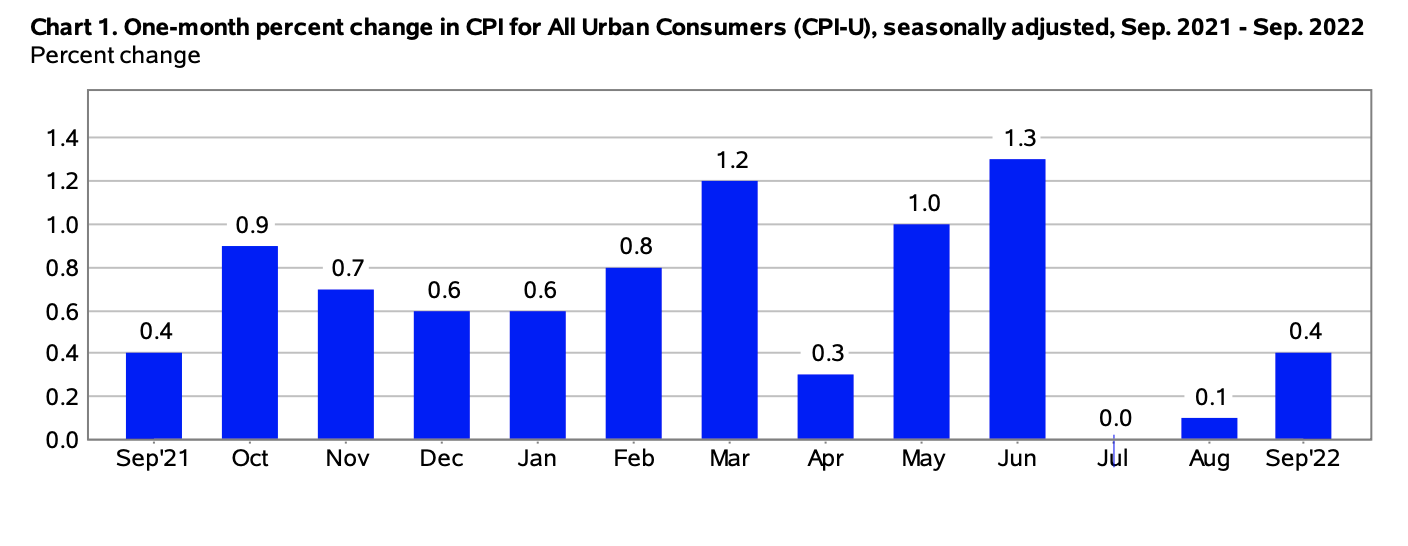
(Source: U.S. Bureau of Labor Statistics)
Gasoline Prices
In September, American consumers once again paid less at the pumps. The price of gasoline declined 4.9% over the month. This marks the third consecutive monthly drop in the price of gasoline, after the 10.6% drop seen in August, and the 7.7% decrease in July.
In September, prior to seasonal adjustment, gasoline prices declined by 5.6%.
Year-over-year, the price of gasoline rose by 18.2%.
Food
In September, the index for food edged up 0.8%, the identical percentage increase seen in August. Over the last 12-month period, American consumers have paid 13% more for food items from grocery stores.
Foodstuffs that saw the largest price increase in September included fruits and vegetables (1.6%), cereals and bakery products (0.9%), meats, poultry, fish, and eggs (0.4%), and non-alcoholic beverages (0.6%). Furthermore, as in August, American consumers paid more to dine out in restaurants in September.
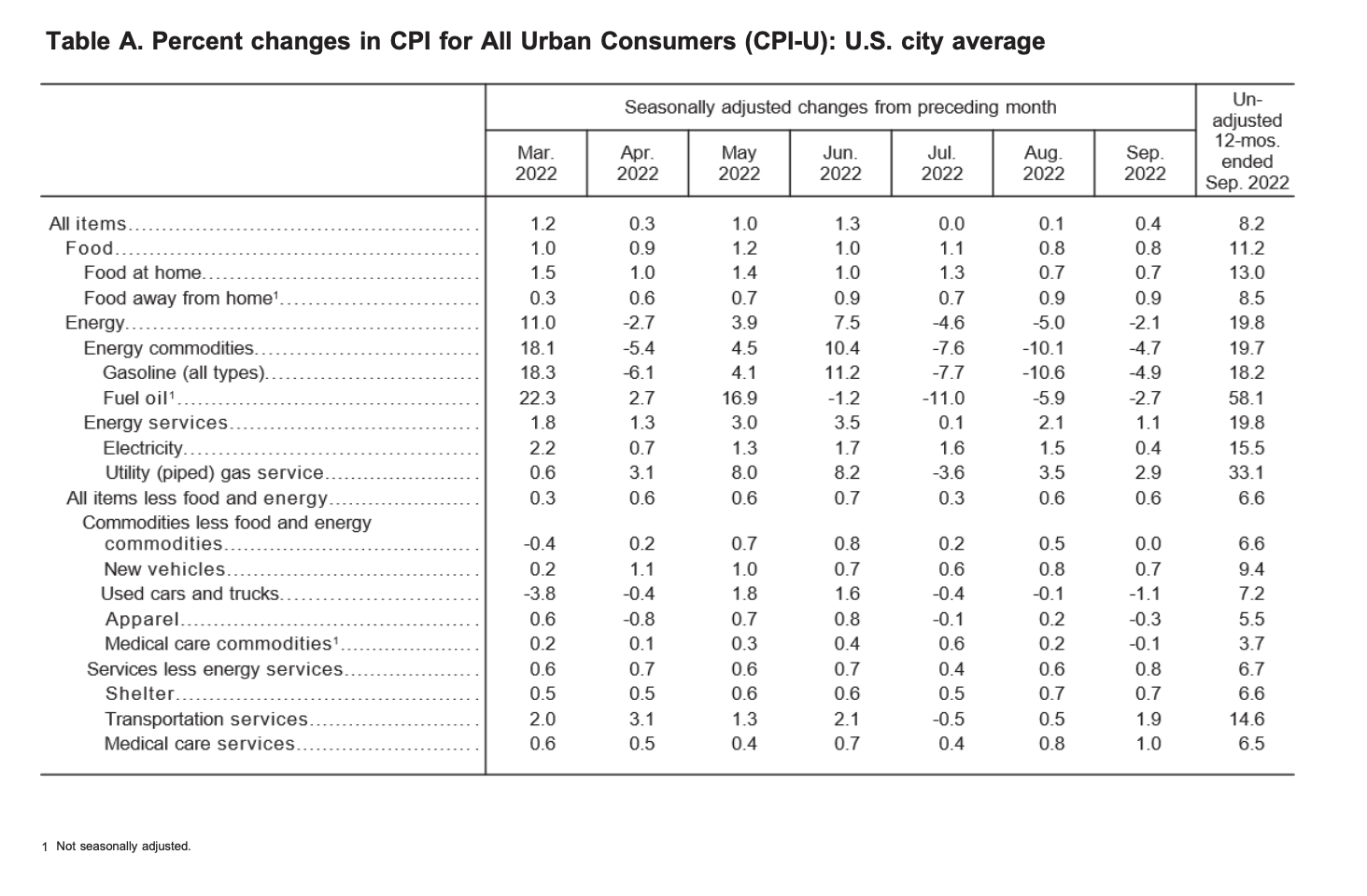
(Source: U.S. Bureau of Labor Statistics)
All Items Less Food and Energy
In September, the all items less food and energy index increased by 0.6%, the same percentage increase seen the previous month. American consumers continued to pay more shelter costs. The index for shelter rose 0.7% for the month.
The index for rent edged up by 0.8%, as did the index for owners’ equivalent rent, which is correlated to the value of housing prices. Furthermore, Americans paid more for medical care, as the medical care index increased by 0.8% in September. The physicians’ services index rose 0.5%, as did the hospital services index by 0.1%.
Conversely, Americans paid 0.1% less for prescription drugs in September.
Since this time last year, the all items less food and energy index grew by 6.6%. The Bureau of Labor Statistics noted that this was the largest year-over-year rise in the index in 40 years, specifically since August 1982.
Over the last 12-month period, the composite index for shelter increased by 6.6% – contributing to over 40% of the percentage rise in the all items less food and energy index.
Want to learn more about how inflation is impacting the economy? Have a look at our table highlighting information regarding the 2022 CPI and Inflation Rate for the United States, try our calculator widget, and subscribe to our newsletter.
Source Cited: https://www.bls.gov/news.release/archives/cpi_10132022.htm
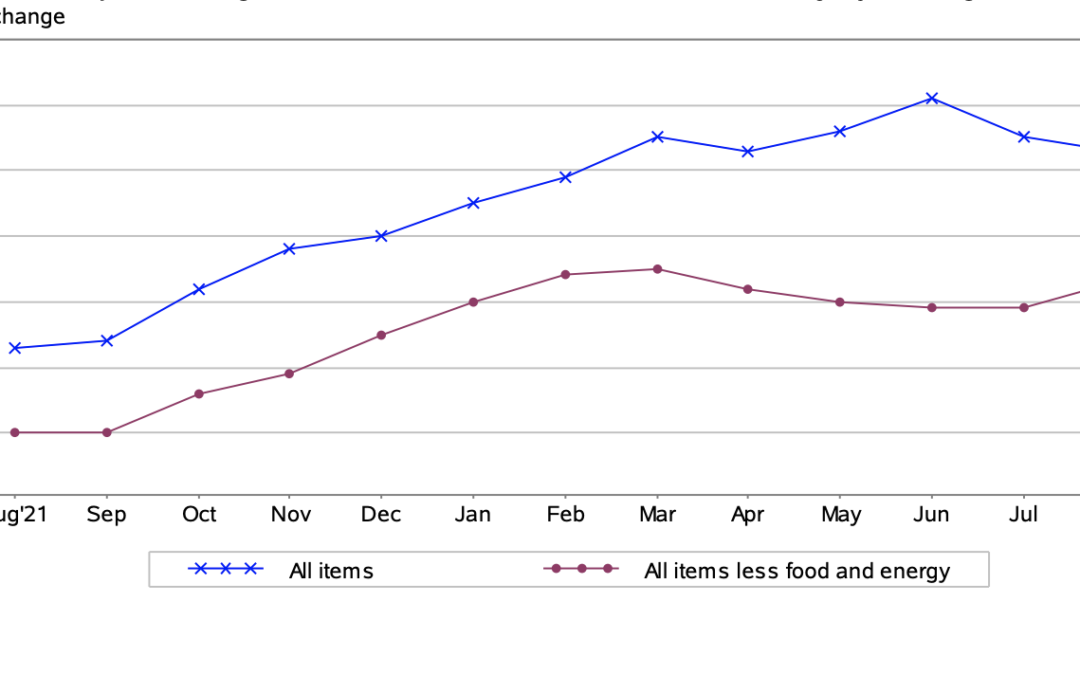
by Sarah Bauder | Sep 13, 2022 | BLS, CPI
The Consumer Price Index for All Urban Consumers (CPI-U) edged up by 0.1% on a seasonally adjusted basis in August, reported the U.S. Bureau of Labor Statistics. Year-over-year, prior to seasonal adjustment the all items index rose 8.3%.
The principal reason for the percentage increase seen in August was a rise in the food, shelter, and medical care indexes. Conversely, there was a 10.6% decrease in the price of gasoline for the month which counteracted percentage increases seen with other indexes.
“The indexes for shelter, medical care, household furnishings and operations, new vehicles, motor vehicle insurance, and education were among those that increased over the month,” explained the Bureau of Labor Statistics in its monthly report.
For American consumers, this means that they paid more for foodstuffs at the grocery store, shelter costs, and medical care costs among other areas of everyday life. The continued acceleration in inflation means many Americans are still grappling with meeting basic daily needs.
Given the fact that inflation is still at historically high levels, last week the Fed indicated that there would likely be a significant increase in interest rates later this month.
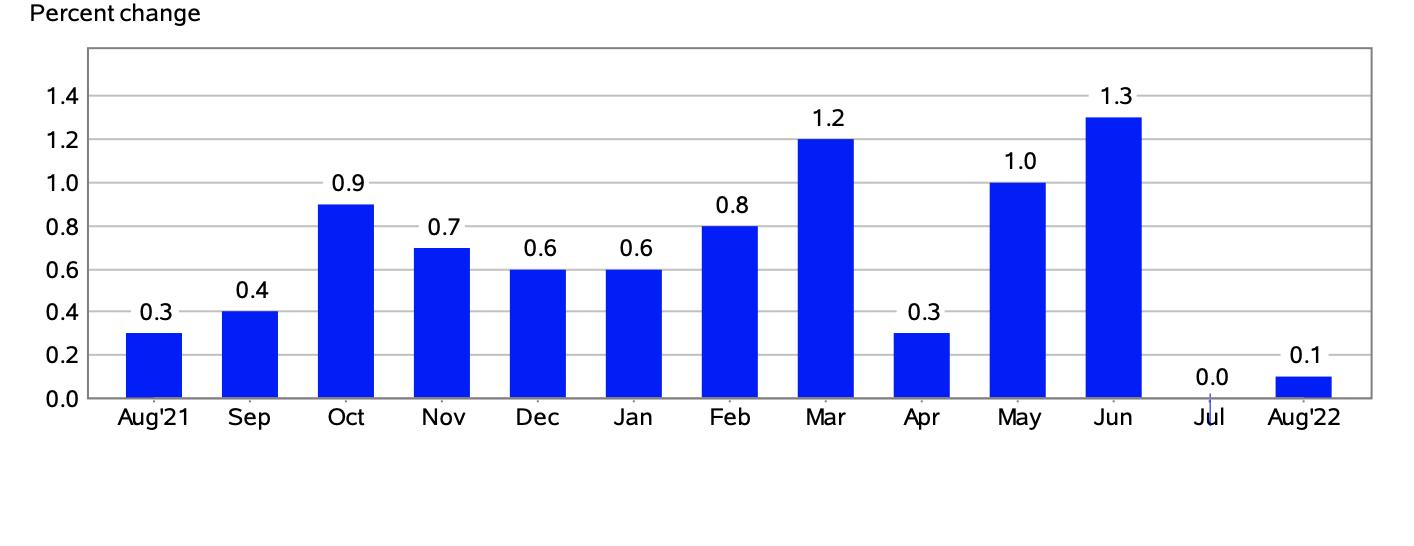
(Source: U.S. Bureau of Labor Statistics)
Food
In August, the index for food rose 0.8%. Since this time last year, American consumers have paid 13.5% more for foodstuffs at grocery stores. It should be noted that this was the highest year-over-year percentage increase seen since May 1979.
Grocery items that were the main contributors to the overall rise in the index included fruits and vegetables, eggs, meat, poultry, fish, cereal products, bakery products, dairy products, and nonalcoholic beverages. In addition, American consumers paid more to dine out at restaurants in August.
The Price of Gasoline
Conversely, American consumers enjoyed a bit of respite at the gas pumps in August. The price of gasoline dropped by 10.6%. This is the second consecutive monthly decline in gas prices following a 7.7% drop at the pumps seen in July.
In August, prior to seasonal adjustment, the price of gasoline dropped by 12.2%.
Over the last 12-month period, gasoline prices soared 25.6%.
Energy
In August, the energy index decreased 5%, largely due to the decline in gas prices. Yet, American consumers paid 1.5% more for electricity over the month. Likewise, the natural gas index also rose by 3.5%.
Since this time last year, the index for energy increased by 23.8%. Year-over-year, the price of fuel oil skyrocketed an astounding 68.8%. Natural gas prices likewise soared 33% since this time last year. In addition, over the last 12-month period, American consumers paid 15.8% more for electricity – the largest year-over-year rise since August 1981.

(Source: U.S. Bureau of Labor Statistics)
All Items Less Food and Energy
In August, the all items less food and energy index edged up 0.6%. American consumers continued to pay more for shelter, as the index rose 0.7% over the month.
Rent prices also increased 0.7%, as did the index for owners’ equivalent rent, which is correlated to the value of housing prices.
Moreover, Americans also paid 0.7% more for medical costs over the month. In August, all major medical care composite indexes saw percentage increases. The hospital services index rose 0.7%, the price of prescription drugs grew by 0.4%, and the physicians’ services index also edged up by 0.2%.
Over the last 12-month period, the all items less food and energy index increased by 6.3%. Year-over-year, the composite index for shelter increased by 6.2%, which contributed to roughly 40% of the total growth of the index for all items less food and energy.
Likewise, American consumers paid 5.4% more for medical care since this time last year.
Want to learn more about how inflation is impacting the economy? Here is our table highlighting the 2022 CPI and Inflation Rate for the United States, try our U.S. inflation calculator, and subscribe to our newsletter.
Source Cited: https://www.bls.gov/news.release/archives/cpi_09132022.htm

















